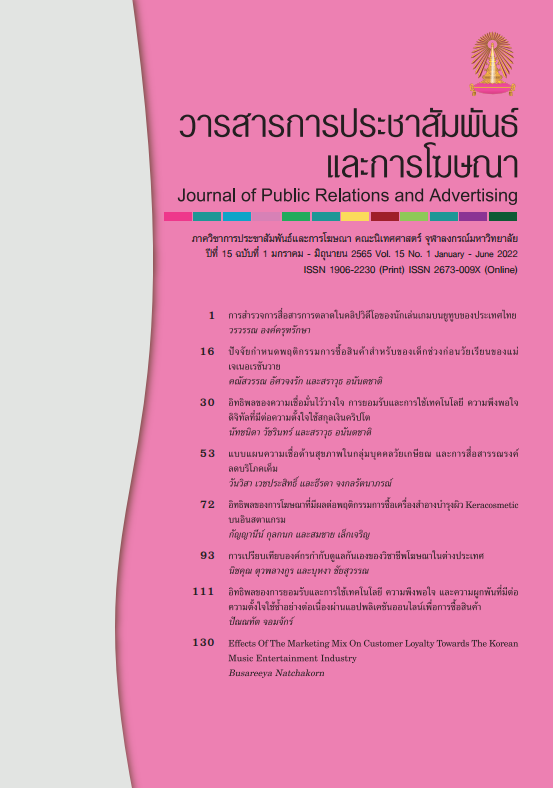รูปแบบการดำเนินชีวิต การเปิดรับสื่อและพฤติกรรมการซื้อสินค้าออนไลน์ ของผู้บริโภคหญิงวัยทำงาน
Main Article Content
บทคัดย่อ
การวิจัยเชิงสำรวจครั้งนี้ มีวัตถุประสงค์เพื่อศึกษา 1) รูปแบบการดำเนินชีวิต การเปิดรับสื่อ และพฤติกรรมการซื้อสินค้าออนไลน์ของผู้บริโภคหญิงวัยทำงาน และ 2) ความสัมพันธ์ระหว่างตัวแปรต่าง ๆ โดยใช้แบบสอบถามเป็นเครื่องมือในการเก็บข้อมูลจากกลุ่มตัวอย่างเพศหญิง อายุ 22 - 44 ปี จำนวน 1,140 คน ที่อาศัยอยู่ในกรุงเทพฯ โดยใช้วิธีการทางสถิติทั้งเชิงพรรณนาและเชิงอนุมาน คือ การวิเคราะห์ปัจจัย (Factor Analysis) และการวิเคราะห์การถดถอยพหุคูณ (Multiple Regression Analysis) ผลการวิจัยพบรูปแบบการดำเนินชีวิตที่แตกต่างกัน 6 กลุ่ม ได้แก่ 1) กลุ่มสาวยุคใหม่ ใช้ชีวิตมีสาระ 2) กลุ่มสาวเพียบพร้อมสมบูรณ์แบบ 3) กลุ่มสาวมั่น เฉียบ ตรงไปตรงมา 4) กลุ่มสาวติดโซเชียล 5) กลุ่มแม่ศรีเรือน ใช้ชีวิตเรียบง่าย และ 6) กลุ่มนางเอกเจ้าน้ำตา สำหรับพฤติกรรมในการเปิดรับสื่อ พบว่า กลุ่มตัวอย่างผู้หญิงวัยทำงานมีการเปิดรับสื่อดั้งเดิมในระดับที่ต่ำ ซึ่งสื่อดั้งเดิมที่ยังเปิดคงรับอยู่ได้แก่ สื่อโทรทัศน์ สื่อโฆษณา ณ จุดซื้อ และสื่อโฆษณากลางแจ้ง และมีการเปิดรับสื่อใหม่ในระดับที่สูง โดย 3 อันดับแรก ได้แก่ โปรแกรมสนทนาไลน์ โปรแกรมสืบค้นข้อมูล และการส่งข้อความทางเฟซบุ๊ก นอกจากนั้น รูปแบบการดำเนินชีวิตที่แตกต่างกัน ยังส่งผลให้การเปิดรับสื่อแต่ละประเภท พฤติกรรมการค้นหาข้อมูลก่อนการซื้อ ประเภทของสินค้าที่ซื้อ และเหตุผลในการซื้อสินค้าผ่านทางออนไลน์ในช่องทางต่าง ๆ มีความแตกต่างกันอีกด้วย
Article Details
เอกสารอ้างอิง
ทีเอ็มบี อนาลิติกส์. (2563). บทบาท e-commerce ต่อการสนับสนุนการบริโภคของไทยในช่วงวิกฤต และโอกาสทางธุรกิจที่รออยู่. วันที่เข้าถึงข้อมูล 10 มิถุนายน 2563, แหล่งที่มา https:// thaipublica.org/2020/05/tmb-analytics-e-commerce-during-covid-19/
ธาราทิพย์ อดุลประเสริฐสุข. (2548) รูปแบบการดำเนินชีวิตของผู้บริโภค พฤติกรรมการใช้บริการอินเทอร์เน็ต และพฤติกรรมการซื้อสินค้าผ่านสื่ออินเทอร์เน็ต. วิทยานิพนธ์ปริญญามหาบัณฑิต สาขาวิชาการโฆษณา จุฬาลงกรณ์มหาวิทยาลัย.
Brandbuffet. (2562). ‘ช้อปปี้’ สร้างประวัติศาสตร์ความสำเร็จสุดยิ่งใหญ่ ในแคมเปญ Shopee 11.11 Big Sale ด้วยยอดขาย 70 ล้านชิ้น!. วันที่เข้าถึงข้อมูล 5 ธันวาคม 2562, แหล่งที่มา https://www.brandbuffet.in.th/2019/11/shopee-big-sale-11-11-2019/
Brandbuffet. (2562). ย้อนรอยแคมเปญ “11.11” ก่อนกลายเป็นอาวุธสำคัญที่ทุกแบรนด์ต้องห้าม พลาด!. วันที่เข้าถึงข้อมูล 5 ธันวาคม 2562, แหล่งที่มา https://www.brandbuffet.in.th/ 2019/11/7-years-lazada-shopping-11-11/
ภาวุธ พงษ์วิทยภานุ. (2551). 6 รูปแบบประเภทของเว็บไซต์ e-Commerce. วันที่เข้าถึงข้อมูล 5 มีนาคม 2563, แหล่งที่มา http://www.pawoot.com/node/327
Marketingoops. (2561). คุณช้อปออนไลน์ครั้งละกี่บาท?. วันที่เข้าถึง ข้อมูล 5 มิถุนายน 2563, แหล่งที่มา https://www.
marketingoops.com/news/ecommerce/the-state-of-ecommerce-in-southeast-asia-2017/
ยุบล เบ็ญจรงค์กิจ. (2534). การวิเคราะห์ผู้รับสาร. กรุงเทพมหานคร: สำนักพิมพ์แห่งจุฬาลงกรณ์มหาวิทยาลัย
รตินันท์ ชัยวิบูลย์เวช. (2562). อยากตีตลาดจีน ต้องทำความรู้จัก Sheconomy อำนาจการซื้อของผู้หญิงยุคใหม่. วันที่เข้าถึงข้อมูล 6 มิถุนายน 2563, แหล่งที่มา https://brandinside. asia/sheconomy-retail-china/
สุมาลี เหลืองดำรงกิจ. (2543). รูปแบบการดำเนินชีวิตของผู้บริโภคสตรีในเขตกรุงเทพมหานคร. วิทยานิพนธ์ปริญญามหาบัณฑิต สาขาวิชาการโฆษณา จุฬาลงกรณ์มหาวิทยาลัย.
สำนักงานพัฒนาธุรกรรมทางอิเล็กทรอนิกส์. (2562). รายงานประจำปีสำนักงานพัฒนาธุรกรรมทางอิเล็กทรอนิกส์ 2562. วันที่เข้าถึงข้อมูล 3 มกราคม 2563, แหล่งที่มา https://www.etda. or.th/documents-for-download.html
สำนักงานสถิติแห่งชาติ. (2561). รายงานการสำรวจการมีการใช้เทคโนโลยีสารสนเทศและการสื่อวารในครัวเรือน ปี 2561. วันที่เข้าถึงข้อมูล 20 พฤษภาคม 2563, แหล่งที่มา https://bit.ly/ 30D7oa7
Agarwal, R., & Karahanna, E. (2000). Time flies when you’re having fun: cognitive absorption and beliefs about information technology usage. MIS Quarterly, 24(4), 665-694.
Assael, H. (2004). Consumer behavior: A strategic approach. Boston, MA: Houghton Mifflin.
Balakrishnan, V., & Shamim, A. (2013). Malaysian facebookers: Motives and addictive behaviors unraveled. Computers in Human Behavior, 29(4), 1342–1349.
Chaffey, D., & Smith, P. R. (2017). Digital marketing excellence: Planning, optimizing and integrating online marketing. London, UK: Routledge.
Chiang, K., & Dholakia, R. (2003) Factors driving consumer intention to shop online: An empirical investigation. Journal of Consumer Psychology, 13(1-2), 177-183.
Deloitte (2015). Navigating the new digital divide. Retrieved February 10, 2020, from https://www2.
deloitte.com/content/dam/Deloitte/us/Documents/consumerusiness/us-cb-navigating-the-new-digital-divide-051315.pdf
Douglas, S. P., & Urban, C. D. (1977). Lifestyle analysis to profile women in international markets. Journal of Marketing, 41(3), 46-54.
Facebook, & Bain&Company. (2019). Riding the digital wave. Retrieved March 1, 2020, from https://www.facebook.com/business/m/riding-the-digital-wave
Gunter, B., & Furnham, A. (1992). Consumer profiles: An introduction to psychographics. London, UK: Routledge.
Hampel, D., & Jadczakova, V. (2010). Analysis and evaluation of questionnaires--Lifestyle segmentation (Diploma thesis). Mendel University, Brno, Czech Republic.
Hawkins, D. I., & Mothersbaugh, D. L. (2016). Consumer behavior: Building marketing Strategy (13th ed.). New York, NY: McGraw-Hill Education.
Jackson, R. W., McDaniel, S. W., & Rao, C. P. (1985). Food shopping and preparation: Psychographic differences of working wives and housewives. Journal of Consumer Research, 12(1), 110–113.
Katz, E., Blumler, J. G., & Gurevitch, M. (1973-1974). Uses and gratifications research. Public Opinion Quarterly, 37(4), 509–523.
Kotler, P. (1997). Marketing management: Analysis, planning, implementation, and Control (9th ed.). Upper Saddle River, NJ: Prentice Hall.
Kotler, P., Kartajaya, H., & Setiawan, I. (2017). Marketing 4.0: Moving from traditional to digital. Hoboken, NJ: John Wiley & Sons.
Krikelas, J. (1983). Information-seeking behavior: Patterns and concepts. Drexel Library Quarterly. (19)2, 5-20.
Laudon, K. C., & Traver, C. G. (2018). E-commerce: Business, technology, society. Boston, MA: Pearson.
Lecinski, J. (2011). ZMOT: Winning the zero moment of truth. Retrieved February 10, 2020, from https://www.thinkwithgoogle.com/marketing-resources/micro-moments/2011-winning-zmot-ebook/
Lester, D., Forman, A., & Loyd, D. (2005). Internet shopping and buying behavior of college students. Services Marketing Quarterly, 27(2), 123-138.
McGaughey, R. E., & Mason K. H. (1998). The internet as a marketing tool. Journal of Marketing Theory and Practice, 6(3), 1-11.
McLeod, J. M., & O’Keefe, G. J. (1972). The socialization prospective and communication behavior. In F. G Kline, & P. J. Tichenor (Eds.), Perspectives in mass communication research (pp. 121-168). Beverly Hills, CA: Sage.
Moon, J. W., & Kim, Y. G. (2001). Extending the TAM for a World-Wide-Web context. Information & Management, 38(4), 217-230.
Plummer, J. T. (1974). The concept and application of lifestyle segmentation. Journal of Marketing, 38(1), 33-37.
Reynolds, F. D., Crask, M. R., & Wells, W. D. (1977). The modern feminine lifestyle Journal of Marketing, 41(3), 38–45.
Rowley, J. (2001). Remodelling marketing communications in an Internet environment. Internet Research, 11(3), 203-212.
Shimp, T. A. (2007). Integrated marketing communications in advertising and promotion (7th ed.). Mason, OH: Thomson/South-Western.
Smith, W. (1956). Product differentiation and market segmentation as alternative marketing strategies. Journal of Marketing, 21(1), 3-8.
Solis, B. (2010). The 10 stages of social media integration in business. Retrieved February 6, 2020, from http://www.briansolis.com/2010/01/the-10-stages-of social-media-integration-in-business/
Solis, B. (2016). To improve CX, Companies must rethink the customer journey to cater to Gen C. Retrieved February 6, 2020, from https://www.briansolis.com/ 2016/04/improve-cx-companies-must-rethink-funnel-cater-gen-c/
Solomon, M. R. (2018). Consumer behavior: Buying, having, and being (12th ed.). Upper Saddle River, NJ: Pearson Prentice Hall.
Statista. (2019). e-Commerce Thailand. Retrieved March 5, 2020, from https://www.statista.com/outlook/243/
/ecommerce/thailand#market-revenue
Teo, T. (2002). Attitudes toward online shopping and the internet. Behavior & Information Technology, 21(4), 259-271.
To, P. L., Liao C., & Lin, T. H. (2007). Shopping motivations on Internet: A study based on utilitarian and hedonic value. Technovation, 27(12), 774-787.
Torkzadeh, G., & Dhillon, G. (2002). Measuring factors that influence the success of internet commerce. Information System Research, 13(2), 187-204.
Venkatesh, A. (1980). Changing roles of women - A lifestyle analysis, Journal of Consumer Research, 7(2), 189–197.
We Are Social Inc. (2020). Digital 2020: Global digital overview. Retrieved January 31, 2020, from https://
wearesocial.com/digital-2020
Wells, W. D., & Tigert, D. J. (1971). Activities, interests, and opinions. Journal of Advertising Research, 11(4), 27–35.
Wertime, K., & Fenwick, I. (2012). DigiMarketing: The essential guide to new media and digital marketing. Singapore: John Wiley & Sons (Asia).
Zeff, R., & Aronson, B. (1999). Advertising on the Internet (2nd ed.). New York: John Wiley & Sons.


